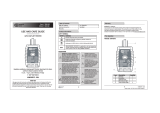
Limited Warranty and Limitation of Liability
Your Amprobe product will be free from defects in material
and workmanship for 1 year from the date of purchase. This
warranty does not cover fuses, disposable batteries or damage
from accident, neglect, misuse, alteration, contamination, or
abnormal conditions of operation or handling. Resellers are
not authorized to extend any other warranty on Amprobe’s
behalf. To obtain service during the warranty period, return the
product with proof of purchase to an authorized Amprobe Test
Tools Service Center or to an Amprobe dealer or distributor.
See Repair Section for details. THIS WARRANTY IS YOUR ONLY
REMEDY. ALL OTHER WARRANTIES - WHETHER EXPRESS,
IMPLIED OR STAUTORY - INCLUDING IMPLIED WARRANTIES OF
FITNESS FOR A PARTICULAR PURPOSE OR MERCHANTABILITY,
ARE HEREBY DISCLAIMED. MANUFACTURER SHALL NOT
BE LIABLE FOR ANY SPECIAL, INDIRECT, INCIDENTAL OR
CONSEQUENTIAL DAMAGES OR LOSSES, ARISING FROM ANY
CAUSE OR THEORY. Since some states or countries do not
allow the exclusion or limitation of an implied warranty or of
incidental or consequential damages, this limitation of liability
may not apply to you.
Repair
All Amprobe tools returned for warranty or non-warranty
repair or for calibration should be accompanied by the
following: your name, company’s name, address, telephone
number, and proof of purchase. Additionally, please include a
brief description of the problem or the service requested and
include the test leads with the meter. Non-warranty repair or
replacement charges should be remitted in the form of a check,
a money order, credit card with expiration date, or a purchase
order made payable to Amprobe.
In-Warranty Repairs and Replacement – All Countries
Please read the warranty statement and check your battery
before requesting repair. During the warranty period, any
defective test tool can be returned to your Amprobe distributor
for an exchange for the same or like product. Please check the
“Where to Buy” section on
www.Amprobe.com for a list of distributors near you.





















